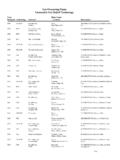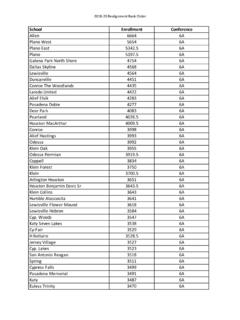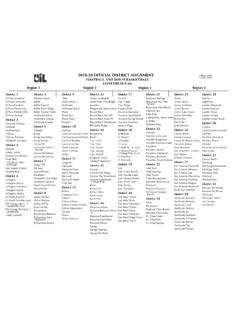Transcription of DESIGNING MOLECULAR SIEVE DEHYDRATION UNITS TO …
1 DESIGNING MOLECULAR SIEVE DEHYDRATION UNITS TO PREVENT UPSETS IN DOWNSTREAM NGL/LPG RECOVERY PLANTS Daryl R. Jensen Ortloff Engineers, Ltd. 415 W. Wall St. Ste. 2000 Midland, Texas 79701 +1(432)685-0277 Joe T. Lynch, Ortloff Engineers, Ltd. 415 W. Wall St. Ste. 2000 Midland, Texas 79701 +1(432)685-0277 Kyle T. Cuellar Ortloff Engineers, Ltd. 415W. Wall St. Ste. 2000 Midland, Texas 79701 +1(432)685-0277 Gabriela G. Villegas Midland, Texas ABSTRACT MOLECULAR SIEVE DEHYDRATION is the industry-standard method of removing water from natural gas upstream of cryogenic NGL/LPG recovery UNITS when significant recovery of light hydrocarbons (ethane and propane) is desired. The design of the DEHYDRATION system regeneration and subsequent cool-down operations can, however, have negative unforeseen impacts on the downstream cryogenic processing unit .
2 Ortloff has designed four cryogenic NGL/LPG recovery UNITS over the last 10 years where undesirable transient effects due to the upstream DEHYDRATION system design have been observed. In each of these facilities, the switching of a freshly regenerated mole SIEVE bed led to temperature and, in some cases, compositional disturbances at the inlet to the cryogenic unit , which then propagated through the entire unit over a 15-30 minute period. These disturbances caused process excursions which affected the recovery level of the unit , plus introduced some undesirable temperature variations at the heat exchangers. This paper analyzes data from the plants in question to show the effects on the cryogenic processing unit associated with the upstream DEHYDRATION unit design, and presents recommendations for the design of MOLECULAR SIEVE DEHYDRATION UNITS which can minimize the disturbances.
3 DESIGNING MOLECULAR SIEVE DEHYDRATION UNITS TO PREVENT UPSETS IN DOWNSTREAM NGL/LPG RECOVERY PLANTS Daryl R. Jensen, Joe T. Lynch, Kyle T. Cuellar, Gabriela G. Villegas Introduction How do I get a stable, steady plant? is a question that is asked by every operator in every gas processing plant. An often overlooked aspect of plant design that affects the stability of a NGL/LPG recovery facility is the DEHYDRATION system. The idea of a DEHYDRATION system for gas processing is a fairly simple one: reduce the water content in the process gas to a level acceptable for both the process design and associated equipment. For plants where significant amounts of propane or ethane are recovered, the industry-standard DEHYDRATION technology is MOLECULAR SIEVE desiccant.
4 As simple as the design of a MOLECULAR SIEVE system is, choices made in the design phase can create disturbances that influence stability of cryogenic processing UNITS downstream. In plants that Ortloff has designed over the past few years, it has been observed that the DEHYDRATION systems introduced cyclical fluctuations in both temperature and inlet feed composition. The objective of this paper is to provide an introduction to mole SIEVE systems, especially as they relate to NGL/LPG recovery plants, provide explanation and examples of possible disturbances caused by mole SIEVE systems, show the associated effects, and offer alternative design strategies that DEHYDRATION system designers can implement to minimize such disturbances in future projects.
5 DEHYDRATION / MOLECULAR SIEVE Fundamentals There are two basic methods of dehydrating a natural gas stream. One is the use of glycols (most commonly triethylene glycol) to absorb water by direct contact with the gas stream. The water-rich glycol is then separated into dry glycol and water by distillation and the now regenerated dry glycol then repeats the cycle. Glycol DEHYDRATION has several benefits; however, it is limited in its ability to reach the exceptionally low water dewpoints required in cryogenic processing UNITS . As such, it can be used in concert with another DEHYDRATION system where the glycol unit provides bulk water removal and the secondary system provides polishing water removal down to the required levels for cryogenic applications.
6 The other basic method for dehydrating a gas stream involves using a solid desiccant to adsorb water from the gas as it passes through. There are several choices for the adsorbent including activated alumina, silica gel, and MOLECULAR SIEVE . MOLECULAR sieves are aluminosilicates (zeolites) which are capable of obtaining the lowest water dew points in DEHYDRATION service. Additionally, MOLECULAR sieves can be used to simultaneously remove sulfurous contaminants and dry the natural gas in preparation for further processing. It is possible with MOLECULAR SIEVE DEHYDRATION UNITS to get the water content of the gas stream down to around ppm by volume. In processes where cryogenic temperatures will be encountered, MOLECULAR SIEVE desiccant is used exclusively.
7 Mole SIEVE DEHYDRATION is more complex and expensive than glycol DEHYDRATION because of the added infrastructure and switching required for regenerating and cooling the desiccant beds; however, only mole sieves can reach the very low water dewpoint values (-150 F [-100 C] or lower) required for cryogenic gas processing. A continuously operating MOLECULAR SIEVE DEHYDRATION system requires two or more beds containing the desiccant. For the simplest two bed case (Figure 1), one bed is in active adsorbing service while the other is going through the desiccant regeneration process. Generally, the active bed is designed to be in service for between 4 and 24 hours depending on the design. After the adsorbing cycle time has elapsed, the active bed is switched into regeneration service and the freshly regenerated bed is put into adsorbing service.
8 The regeneration process involves heating the bed to a temperature well in excess of the boiling point of water (as high as 600 F [315 C]) to ensure that all adsorbed water is driven off. After a sufficient time at high temperature to ensure complete desorption of the water, the bed is cooled back down to prepare it to again receive process gas. It is common practice to use the same dry gas supply for both the heating and cool-down of the bed. In the heating case, the dry gas is heated by some means to the required temperature and in the cool-down case the gas is used as-is or cooled by some other heat exchange system ( , air cooling, water cooling, external refrigeration.) Figure 1: Simplified Process Flow Diagrams of a Two-Bed MOLECULAR SIEVE DEHYDRATION System showing the Regeneration Cycle.
9 Valve OpenProcess Gas OutletProcess Gas SupplySpent Regen. GasWaste WaterValve ClosedValve OpenProcess Gas OutletProcess Gas SupplySpent Regen. GasWaste WaterValve ClosedValve OpenProcess Gas OutletProcess Gas SupplySpent Regen. GasWaste WaterValve ClosedValve OpenProcess Gas OutletProcess Gas SupplySpent Regen. GasWaste WaterValve ClosedHeating Bed 2 Cooling Bed 2 Heating Bed 1 Cooling Bed 1 Frequently, DEHYDRATION systems with more than two beds are utilized to control cycle time, equipment size for a given throughput, and possibly provide redundancy. The array of beds is intended to ensure that there are always enough active adsorbing beds to handle the processing capacity of the facility, while the inactive beds are either in the heating or cool-down phase of the regeneration cycle.
10 Introduction to Cryogenic Gas Processing Ortloff designs UNITS for the recovery of propane+ and ethane+ products from natural gas streams. These plants take natural gas at high pressure and expand it using turboexpanders to produce a two-phase mixture, which is then distilled to provide a liquid product meeting industry specifications and a residue gas product which is subsequently recompressed by the turboexpander-coupled compressor and, in most cases, a larger independent compressor. After recompression, the residue gas is sent to a pipeline, utilized as fuel gas, or otherwise used as the facility owner desires. These plants, like any turboexpander cryogenic gas plant, are sensitive to changes in the inlet conditions.











![Home [www.sa-trackandsignal.net]](/cache/preview/a/f/6/9/4/e/b/b/thumb-af694ebb53633aa11c7e5e477c8c4ca0.jpg)




